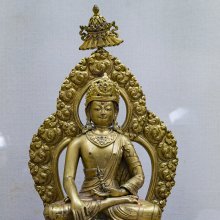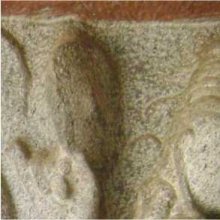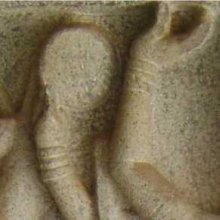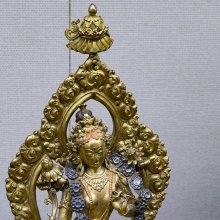Pa: 20 definitions
Introduction:
Pa means something in Hinduism, Sanskrit, Buddhism, Pali, the history of ancient India, Marathi, Jainism, Prakrit, Hindi, biology, Tamil. If you want to know the exact meaning, history, etymology or English translation of this term then check out the descriptions on this page. Add your comment or reference to a book if you want to contribute to this summary article.
Images (photo gallery)
(+12 more images available)
In Hinduism
Vyakarana (Sanskrit grammar)
Source: Wikisource: A dictionary of Sanskrit grammarPa (प).—Or (पकार (pakāra)) the consonant प् (p), the vowel अ (a) and the affix कार (kāra) being added for facility of understanding and pronunciation; cf T.Pr. I. 17, 21 ; प (pa) is also used as a short term for consonants of the fifth class (पवर्ग (pavarga)); cf. T. Pr. 1.27; V. Pr. I. 64 and R. T. 13.

Vyakarana (व्याकरण, vyākaraṇa) refers to Sanskrit grammar and represents one of the six additional sciences (vedanga) to be studied along with the Vedas. Vyakarana concerns itself with the rules of Sanskrit grammar and linguistic analysis in order to establish the correct context of words and sentences.
Purana and Itihasa (epic history)
Source: archive.org: Puranic EncyclopediaPa (प).—A garden. (Agni Purāṇa, Chapter 348).

The Purana (पुराण, purāṇas) refers to Sanskrit literature preserving ancient India’s vast cultural history, including historical legends, religious ceremonies, various arts and sciences. The eighteen mahapuranas total over 400,000 shlokas (metrical couplets) and date to at least several centuries BCE.
India history and geography
Source: Cologne Digital Sanskrit Dictionaries: Indian Epigraphical GlossaryPa.—(CITD), abbreviation of the Telugu name of a certain measure of grain. Note: pa is defined in the “Indian epigraphical glossary” as it can be found on ancient inscriptions commonly written in Sanskrit, Prakrit or Dravidian languages.
--- OR ---
Pā.—(EI 32), contraction of the surname Pāṭhin. Note: pā is defined in the “Indian epigraphical glossary” as it can be found on ancient inscriptions commonly written in Sanskrit, Prakrit or Dravidian languages.
--- OR ---
Pā.—(IE 8-1), abbreviation of pāda. Note: pā is defined in the “Indian epigraphical glossary” as it can be found on ancient inscriptions commonly written in Sanskrit, Prakrit or Dravidian languages.
--- OR ---
Pa.—d8irā, cf. Od8iyā Sāmanta-pad8irā (EI 32); Sanskrit Prati- rāja; title of a fendatory or governor; cf. Pratirājya = Pratirāja. Note: pa is defined in the “Indian epigraphical glossary” as it can be found on ancient inscriptions commonly written in Sanskrit, Prakrit or Dravidian languages.
--- OR ---
Pa.—ṟṟu (IE 8-4), Tamil; a small territorial unit. Note: pa is defined in the “Indian epigraphical glossary” as it can be found on ancient inscriptions commonly written in Sanskrit, Prakrit or Dravidian languages.
--- OR ---
Pa.—ḻanel (SII 13), a tax. Note: pa is defined in the “Indian epigraphical glossary” as it can be found on ancient inscriptions commonly written in Sanskrit, Prakrit or Dravidian languages.

The history of India traces the identification of countries, villages, towns and other regions of India, as well as mythology, zoology, royal dynasties, rulers, tribes, local festivities and traditions and regional languages. Ancient India enjoyed religious freedom and encourages the path of Dharma, a concept common to Buddhism, Hinduism, and Jainism.
Biology (plants and animals)
Source: Google Books: CRC World Dictionary (Regional names)Pa in Ivory Coast is the name of a plant defined with Celtis mildbraedii in various botanical sources. This page contains potential references in Ayurveda, modern medicine, and other folk traditions or local practices It has the synonym see J.H. Barnhart, Biographical Notes upon Botanists. 2: 489. 1965 (among others).
Example references for further research on medicinal uses or toxicity (see latin names for full list):
· Botanische Jahrbücher für Systematik, Pflanzengeschichte und Pflanzengeographie (1909)
If you are looking for specific details regarding Pa, for example chemical composition, diet and recipes, health benefits, pregnancy safety, side effects, extract dosage, have a look at these references.

This sections includes definitions from the five kingdoms of living things: Animals, Plants, Fungi, Protists and Monera. It will include both the official binomial nomenclature (scientific names usually in Latin) as well as regional spellings and variants.
Languages of India and abroad
Pali-English dictionary
Source: Sutta: The Pali Text Society's Pali-English DictionaryPa°, (indecl.) (Ved. pra, Idg. *pro, cp. Gr. prό, Lat. pro, Goth. fra, Lith. pra, prō, Oir. ro-) directional prefix of forward motion, in applied sense often emphasising the action as carried on in a marked degree or even beyond its mark (cp. Ger. ver- in its function of Goth. fra & Ger. vor). Thus the sphere of pa- may be characterised in foll. applications: 1. forth, forward, out: papatati fall forward, i.e. down; °neti bring forth (to); °gaṇhāti hold out; °tharati spread forth; °dhāvati run out; °bajati go forth; °sāreti stretch out; etc.—2. (intensive) in a marked degree, more than ordinarily (cp. E. up in cut up, heap up, fill up; thus often to be translated by “up, ” or “out, ” or “about”): pakopeti up-set; °chindati cut up; °bhañjati break up; °cinati heap up; °kiṇṇaka scattered about; °nāda shouting out; °bhāti shine forth; °bhavati grow up, prevail; °dūseti spoil entirely; °jahati give up entirely; °tapeti make shine exceedingly (C. ativiya dīpeti); °jalati blaze up; °jānāti know well.—In this meaning often with adjectives like patanu very thin; °thaddha quite stiff; °dakkhiṇa right in pre-eminence; °bala very strong.—3. “onward”: paṭṭhāya from ... onward; pavattati move on; fig. “further, later”: paputta a later (secondary) son, i.e. grandson.—4. “in front of, ” “before”: padvāra, before the door.—5. Sometimes in trs. (reflexive) use, like pakūjin singing out to (each other, cp Ger. besingen, an-rufen). -The most frequent combination with other (modifying) prefixes is sam-ppa; its closest relatives (in meaning 2 especially) are ā and pari. The double (assimilation) p is restored after short vowels, like appadhaṃsiya (a+pa°). (Page 378)

Pali is the language of the Tipiṭaka, which is the sacred canon of Theravāda Buddhism and contains much of the Buddha’s speech. Closeley related to Sanskrit, both languages are used interchangeably between religions.
Marathi-English dictionary
Source: DDSA: The Molesworth Marathi and English Dictionarypa (प).—The twenty-first consonant, corresponding with P.
--- OR ---
pa (प).—a S That preserves or keeps: also that drinks. In comp. as bhūmipa Preserver of the earth; dhanapa Keeper of the treasures; a name of Kuber; raktapa A drinker of blood; a bug, a Rakshas &c.; madhupa A drinker of honey; a bee. Words so formed are constantly occurring in poetry.
Source: DDSA: The Aryabhusan school dictionary, Marathi-Englishpā (पा).—n -
--- OR ---
pa (प).—The twenty-first consonant. corres- ponding with P.
--- OR ---
pa (प).—a That preserves or keeps. Ex. dhanapa. That drinks. Ex. madhupa.
--- OR ---
pa (प).—A particle and prefix implying Pro- gressive motion forth, forward, away &c.); Excess or excellence (very much, exceedingly).
Marathi is an Indo-European language having over 70 million native speakers people in (predominantly) Maharashtra India. Marathi, like many other Indo-Aryan languages, evolved from early forms of Prakrit, which itself is a subset of Sanskrit, one of the most ancient languages of the world.
Sanskrit dictionary
Source: DDSA: The practical Sanskrit-English dictionaryPa (प).—a. (At the end of comp.)
1) Drinking; as in द्विप, अनेकप (dvipa, anekapa).
2) Guarding, protecting, ruling; as in गोप (gopa). नृप, क्षितिप (nṛpa, kṣitipa).
-paḥ 1 Air, wind.
2) A leaf.
3) An egg,
4) The act of drinking; also पा (pā).
5) (in music) The fifth note of the gamut.
--- OR ---
Pā (पा).—I. 1 P. (pibati, pīta; pass. pīyate)
1) To drink, quaff; पिब स्तन्यं पोत (piba stanyaṃ pota) Bv.1.6; दुःशासनस्य रुधिरं न पिबाम्युरस्तः (duḥśāsanasya rudhiraṃ na pibāmyurastaḥ) Ve.1.15; R.3.54; Kumārasambhava 3.36; Mālatīmādhava (Bombay) 8.5; Bhaṭṭikāvya 14.92; 15.6.
2) To kiss; पिबत्यसौ पाययते च सिन्धूः (pibatyasau pāyayate ca sindhūḥ) R.13.9; Ś. 1.23.
3) To drink in, inhale; पिबन् यशो मूर्तमिवाबभासे (piban yaśo mūrtamivābabhāse) R. 7.63.
4) To drink in (with the eyes or ears); feast on, look at or listen to intently; समदुःखः पीयते नयनाभ्याम् (samaduḥkhaḥ pīyate nayanābhyām) V.1; निवातपद्मस्तिमितेन चक्षुषा नृपस्य कान्तं पिबतः सुताननम् (nivātapadmastimitena cakṣuṣā nṛpasya kāntaṃ pibataḥ sutānanam) R.3.17; 2.19,93;11.36;13.3; Meghadūta 16; Kumārasambhava 7.
5) To absorb, drink or swallow up; (bāṇaiḥ) आयुर्देहातिगैः पीतं रुधिरं तु पतत्रिभिः (āyurdehātigaiḥ pītaṃ rudhiraṃ tu patatribhiḥ) R.12.48.
6) To drink intoxicating liquors. -Caus. (pāyayati-te)
1) To cause to drink, give to drink; अनन्यसामान्यकलत्रवृत्तिः पिबत्यसौ पाययते च सिन्धूः (ananyasāmānyakalatravṛttiḥ pibatyasau pāyayate ca sindhūḥ) R.13.9; Bhaṭṭikāvya 8.41,62.
2) To water. -Desid. (pipāsati) To wish to drink &c.; हालाहलं खलु पिपासति कौतुकेन (hālāhalaṃ khalu pipāsati kautukena) Bv. 1.95. -II.2 P. (pāti, pāta)
1) To protect, guard, keep, defend, preserve; (oft. with abl.); पर्याप्तोऽसि प्रजाः पातुम् (paryāpto'si prajāḥ pātum) R.1.25; पान्तु त्वां (pāntu tvāṃ)......भूतेशस्य भुजङ्गवल्लिवलयस्रङ्नद्धजूटा जटाः (bhūteśasya bhujaṅgavallivalayasraṅnaddhajūṭā jaṭāḥ) Mālatīmādhava (Bombay) 1.2; जीवन् पुनः शश्वदुपप्लवेभ्यः प्रजाः प्रजानाथ पितेव पासि (jīvan punaḥ śaśvadupaplavebhyaḥ prajāḥ prajānātha piteva pāsi) R.2.48.
2) To rule, govern; पान्तु पृथ्वीं (pāntu pṛthvīṃ)...भूपाः (bhūpāḥ) Mṛcchakaṭika 1. 61.
3) To beware of.
4) Ved. To observe, notice.
5) To keep, observe, tend, take notice of. -Caus. (pālayati- te)
1) To protect, guard, keep, preserve; कथं दुष्ठुः स्वयं धर्मे प्रजास्त्वं पालयिष्यसि (kathaṃ duṣṭhuḥ svayaṃ dharme prajāstvaṃ pālayiṣyasi) Bhaṭṭikāvya 6.132; Manusmṛti 9.18; R.9.2.
2) To rule, govern; तां पुरीं पालयामास (tāṃ purīṃ pālayāmāsa) Rām.
3) To observe, keep, adhere to, fulfil (as a vow or promise); पालितसङ्गराय (pālitasaṅgarāya) R.13.65.
4) To bring up, nourish, maintain.
5) To wait for; अत्रोपविश्य मुहूर्तमार्यः पालयतु कृष्णागम- नम् (atropaviśya muhūrtamāryaḥ pālayatu kṛṣṇāgama- nam) Ve.1.
--- OR ---
Pā (पा).—a. (At the end of comp.)
1) Drinking, quaffing; as in सोमपाः, अग्रेपाः (somapāḥ, agrepāḥ) &c.
2) Protecting, guarding, keeping; गोपा (gopā).
Source: Cologne Digital Sanskrit Dictionaries: Shabda-Sagara Sanskrit-English DictionaryPa (प).—The twenty-first consonant of the Deva Nagri alphabet, corresponding to the letter P.
--- OR ---
Pa (प).—m.
(-paḥ) 1. Air, wind 2. A prince, a ruler. 3. A leaf. 4. An egg. f.
(-pā) (at the end of compounds). 1. Drinking, (as in anekapa) 2. Guarding, Protecting, ruling. (As in gopa) E. pā to nourish, &c. aff. ḍa .
--- OR ---
Pā (पा).—r. 1st. cl. (pivati) To drink. r. 2nd. cl. (pāti) To cherish, to nourish, to protect or preserve. pāne, bhvā-para-saka-aniṭ . rakṣaṇe, adā-para-saka-seṭ .
--- OR ---
Pā (पा).—mfn. (pāḥ-pāḥ-paṃ) 1. Who drinks. 2. Who protects or cherishes. 3. To feast on, (with the eyes or ears.) 4. To absorb, to swallow up, to destroy. E. pā to drink, &c. kvip aff.
Source: Cologne Digital Sanskrit Dictionaries: Benfey Sanskrit-English DictionaryPa (प).—[-pa], latter part of a comp. adj. or subst. derived from adj. I. (vb. 1. pā), Drinking, cf. pāda-pa, properly, Drinking by means of the foot, i. e. a tree. Ii. (vb. 2. pā), 1. Guarding, e. g. dvāra-pa, m. properly, Guarding a door, i. e. a doorkeeper. 2. Ruling, e. g. kṣiti-pa, m. properly, Ruling the earth, = a king; daśapa, i. e. daśan -pa, m. A governor of ten villages.
--- OR ---
Pā (पा).—i. 1, base of the pres. piba, piva, [Parasmaipada.] (in epic poetry also [Ātmanepada.]), 1. To drink, [Mānavadharmaśāstra] 4, 63. 2. with rajas, To quaff dust, [Mānavadharmaśāstra] 11, 110. 3. To enjoy, e. g. with cakṣuṣā, [Meghadūta, (ed. Gildemeister.)] 16. 4. (figuratively) To swallow up, [Pañcatantra] iii. [distich] 233. Ptcple. of the pf. pass., pīta, 1. Drunk. 2. Enjoyed. 3. Swallowed up, squandered away, [Rājataraṅgiṇī] 5, 421. 4. Having drunk, [Kathāsaritsāgara, (ed. Brockhaus.)] 39, 57. 5. Filled. Ptcple. of the fut. pass., peya, Drinkable. I. n. Drink, beverage, [Pañcatantra] 47, 8 (at the end of a comp. adj., nānā-prakāra-vastra-puṣpa-bhakṣya-peya, Accompanied by garments, flowers, food, and drink of different kinds). Ii. f. yā, Rice gruel. pānīya, Drinkable. n. 1. Beverage. 2. Water, [Mānavadharmaśāstra] 8, 326. Comp. A-, adj. not drinkable. [Causal.] pāyaya, To cause to drink, Mahābhārata 1, 192. Desider. pipāsa, To desire to drink, Mahābhārata 7, 705. Ptcple. of the pf. pass., pipāsita, Thirsty, 3, 17247. Frequentat. pepīya, 1. To drink repeatedly or greedily. 2. To be drunk greedily (pass., probably to be corrected to pepīyya). [Bhāgavata-Purāṇa, (ed. Burnouf.)] 5, 8, 1; [Harivaṃśa, (ed. Calc.)] 8798.
— With the prep. ati ati, [Causal.] To cause to drink plenty of (acc.).
— With anu anu, 1. To drink after or afterwards, [Raghuvaṃśa, (ed. Stenzler.)] 8, 67. 2. To drink of, [Rāmāyaṇa] 2, 104, 5 Gorr.
— With abhi abhi, To drink of.
— With ā ā, 1. To drink up, [Rāmāyaṇa] 3, 55, 9. 2. To drink. 3. To imbibe (figuratively) with one’s ears, [Bhāgavata-Purāṇa, (ed. Burnouf.)] 3, 13, 49. [Causal.] To cause to imbibe, [Bhāgavata-Purāṇa, (ed. Burnouf.)] 1, 18, 12.
— With samā sam-ā, 1. To imbibe, Kām. Nīt. 12, 48. 2. To press, to impoverish, Mahābhārata 12, 3307.
— With ni ni, 1. To sip in, [Rāmāyaṇa] 2, 95, 18. 2. To drink. 3. To absorb, [Bhāgavata-Purāṇa, (ed. Burnouf.)] 3, 10, 6. [Causal.] To cause to sip in, [Bhāgavata-Purāṇa, (ed. Burnouf.)] 8, 2, 25.
— With nis nis, niṣpīta, Dried up, [Rāmāyaṇa] 2, 62, 17 Gorr.
— With pari pari, To drink up, [Ṛtusaṃhāra] 3, 6. paripīta, Imbibed.
— With pra pra, 1. To begin to drink. 2. To drink. 3. To enjoy, [Rāmāyaṇa] 2, 45, 5.
— With sam sam, [Causal.] To cause to drink, [Bhāgavata-Purāṇa, (ed. Burnouf.)] 5, 26, 26.
— Cf. [Latin] bibo, potare, poculum, etc.; (cf. pinv),
--- OR ---
Pā (पा).—ii. 2, [Parasmaipada.] 1. To guard, Mahābhārata 14, 514. 2. To preserve, [Bhāgavata-Purāṇa, (ed. Burnouf.)] 1, 3, 15. 3. To beware of (with abl.), Mahābhārata 1, 3417. 4. To govern. [Causal.] and pal, pāl, i. 10, pālaya (properly, a [denominative.] derived from pāla), 1. To protect, [Rāmāyaṇa] 1, 45, 29. 2. To guard as guardian, [Rājataraṅgiṇī] 5, 227. 3. To cherish, Māl. 48, 19. 4. To govern, [Pañcatantra] i. [distich] 253. Comp. ptcple. of the pf. pass. nidhi-pālita, m. A proper name. vasu-, m. A proper name.
— With the prep. anu anu, [Causal.] 1. To cause to be guarded, [Mānavadharmaśāstra] 8, 27. 2. To observe, Mahābhārata 2, 2509; to maintain, [Harivaṃśa, (ed. Calc.)] 3762.
— With samanu sam-anu, [Causal.] 1. To observe, Mahābhārata 12, 476. 2. To keep, [Rāmāyaṇa] 2, 26, 27.
— With abhi abhi, [Causal.] To assist, Mahābhārata 3, 8472.
— With samabhi sam-abhi, [Causal.] To govern, [Harivaṃśa, (ed. Calc.)] 5233.
— With ni ni, To protect, [Rāmāyaṇa] 5, 81, 22. [Causal.] To govern, [Rāmāyaṇa] 1, 6, 29 Gorr.
— With pari pari, 1. To protect, Mahābhārata 1, 8413. 2. To maintain, [Bhāgavata-Purāṇa, (ed. Burnouf.)] 3, 1, 36. [Causal.] 1. To protect, to guard, to govern. 2. To maintain, to keep,
— With pra pra, To beware of (with abl.), [Bhāgavata-Purāṇa, (ed. Burnouf.)] 6, 8, 17. [Causal.] To protect.
— With prati prati, [Causal.] 1. To protect, Mahābhārata 1, 4080. 2. To maintain, to observe, 1, 3521. 3. To expect, to wait, [Śākuntala, (ed. Böhtlingk.)] 9, 4.
— With saṃprati sam-prati, [Causal.] To wait.
— With sam sam, 1. [Causal.] To protect, Mahābhārata 12, 2667. 2. To maintain, to keep, Mahābhārata 3, 15249. 3. To overcome, Mahābhārata 4, 2321. 2. pā is akin to 1. pā; the link between the signification To drink and To protect is formed by the signification To nourish.
— Cf. akin is also [Gothic.] fôdjan; [Anglo-Saxon.] foda; [Latin] pasco, pabulum;
Source: Cologne Digital Sanskrit Dictionaries: Cappeller Sanskrit-English DictionaryPa (प).—1. (—°) drinking.
--- OR ---
Pa (प).—2. (—°) protecting, keeping.
--- OR ---
Pā (पा).—1. pibati pibate (pāti) [participle] pīta (with pass., [rarely] with act. mg), drink, imbibe, swallow, draw in, enjoy. [Causative] pāyayati, [participle] pāyita give to drink (2 [accusative]). [Desiderative] pipāsati (pipīṣati) wish to drink, be thirsty. [Intensive] pepīyate drink greedily or repeatedly (also [with] pass. mg).
--- OR ---
Pā (पा).—2. [adjective] drinking (—°).
--- OR ---
Pā (पा).—3. pāti ([participle] pāna) protect, watch, shelter from or defend against ([ablative]); rule, govern; keep, observe.
--- OR ---
Pā (पा).—4. [adjective] protecting, guarding, keeping (—°).
Source: Cologne Digital Sanskrit Dictionaries: Monier-Williams Sanskrit-English Dictionary1) Pa (प):—1. pa the first labial consonant.
2) 2. pa mf(pā and pī)n. (√1. pā) drinking (cf. aṃhri-, anekaetc.; also paka in taila-paka)
3) mf. the act of drinking, [cf. Lexicographers, esp. such as amarasiṃha, halāyudha, hemacandra, etc.]
4) 3. pa mfn. (√3. pā) guarding, protecting, ruling (ifc.; cf. aja-, kulaetc.; also paka in hasti-paka)
5) Pā (पा):—[from pa] a f. guarding, protecting, [cf. Lexicographers, esp. such as amarasiṃha, halāyudha, hemacandra, etc.]
6) Pa (प):—4. pa m. (in music for pañcama) the fifth note of the gamut.
7) 5. pa m. (only [cf. Lexicographers, esp. such as amarasiṃha, halāyudha, hemacandra, etc.]) wind
8) a leaf
9) = pūta
10) Pā (पा):—[v.s. ...] b f. = pūta and pūritaka.
11) 1. pā [class] 1. [Parasmaipada] ([Dhātupāṭha xxii, 27]) pibati ([Vedic or Veda] and [Epic] also [Ātmanepada] te; rarely pipati, te, [Kāṭhaka; Brāhmaṇa]) [class] 2. pāti, pāthas, pānti, [Ṛg-veda; Atharva-veda]; p. [Ātmanepada] papāna, [Ṛg-veda], pipāna, [Atharva-veda] ([perfect tense] [Parasmaipada] papau, 2. sg. papātha, [Ṛg-veda]; papitha, [Pāṇini 6-4, 64 [Scholiast or Commentator]]; papīyāt, [Ṛg-veda]; p. papivas, [Atharva-veda]; [Ātmanepada] pape, papire, [Ṛg-veda]; p. papāna, [ib.]; [Aorist] or [imperfect tense] apāt, [Ṛg-veda] cf. [Pāṇini 2-4, 77]; 3. [plural] apuḥ [?] [Ṛg-veda i, 164, 7]; -pāsta, [Atharva-veda xii, 3, 43]; Prec. 3. sg. peyās, [Ṛg-veda]; [future] pāsyati, te, [Brāhmaṇa] etc.; pātā [grammar]; [indeclinable participle] pītvā, [Ṛg-veda] etc. etc., tvī, [Ṛg-veda]; -pāya, [Atharva-veda] etc. etc.; -pīya, [Mahābhārata]; pāyam, [Kāvyādarśa]; [infinitive mood] pibadhyai, [Ṛg-veda]; pātum, [Mahābhārata] etc.; pātave, [Atharva-veda; Brāhmaṇa]; pātavai, [Ṛg-veda]),
—to drink, quaff, suck, sip, swallow (with [accusative], rarely [genitive case]), [Ṛg-veda] etc. etc.;
— (met.) to imbibe, draw in, appropriate, enjoy, feast upon (with the eyes, ears etc.), [Manu-smṛti; Mahābhārata; Kāvya literature] etc.;
—to drink up, exhaust, absorb, [Bhāgavata-purāṇa; Pañcatantra];
—to drink intoxicating liquors, [Buddhist literature] :—[Passive voice] pīyate, [Atharva-veda] etc. etc.:—[Causal] pāyayati, te ([perfect tense] pāyayām āsā, [Mahābhārata]; [Aorist] apīpyat, [Pāṇini 7-4, 4]; [indeclinable participle] pāyayitvā, [Mahābhārata]; [infinitive mood] pāyayitavai, [Śatapatha-brāhmaṇa]),
—to cause to drink, give to drink, water (horses or cattle), [Ṛg-veda] etc. etc.:—[Desiderative] pipāsati ([Ṛg-veda] also pipīṣati), to wish to drink, thirst, [ib.] :—[Desiderative] of [Causal] pipāyayiṣati, to wish or intend to give to drink, [Kāṭhaka] :—[Intensive] pepīyate (p. yamāna also with pass meaning), to drink greedily or repeatedly, [Upaniṣad; Harivaṃśa]
12) cf. [Greek] πέ-πω-κα; [Aeolic] πώ-νω = πίνω; [Latin] pā-tus, pōtum, bibo for pi-bo; [Slavonic or Slavonian] pi-ja, pi-ti
13) 2. pā mfn. drinking, quaffing etc. (cf. agre-, ṛtu-, madhu-, somaetc.)
14) 3. pā [class] 2. [Parasmaipada] ([Dhātupāṭha xxiv, 48]) pāti ([imperative] pāhi; [present participle] [Parasmaipada] pāt [Ātmanepada] pāna, [Ṛg-veda]; [perfect tense] papau [grammar]; [Aorist] apāsīt, [Rājataraṅgiṇī] [subjunctive] pāsati, [Ṛg-veda]; [future] pāsyati, pātā [grammar]; Prec. pāyāt, [Pāṇini 6-4, 68 [Scholiast or Commentator]]; [infinitive mood] pātum, [Mahābhārata]),
—to watch, keep, preserve;
—to protect from, defend against ([ablative]), [Ṛg-veda] etc. etc.;
—to protect (a country) id est. rule, govern, [Rājataraṅgiṇī];
—to observe, notice, attend to, follow, [Ṛg-veda; Aitareya-brāhmaṇa] :—[Causal] pālayati See √pāl:—[Desiderative] pīpāsati [grammar]:—[Intensive] pāpāyate, pāpeti, pāpāti, [ib.,]
15) cf. [Zend] pā, paiti; [Greek] πά-ομαι, πέ-πα-μαι, πῶ-ν, etc.; [Latin] pa-sco, pa-bulum; [Lithuanian] pë-mů
16) 4. pā mfn. keeping, protecting, guarding etc. (ef. apāna-, ritā-, go-, tanūetc.)
17) 5. pā add √5. pā, [class] 3. [Ātmanepada] pīpīte, to rise against, be hostile (see 2. anūt-√5. pā, p. 41; 2. ut-pā, p. 181; praty-ut - √5. pā, p. 677).
Source: Cologne Digital Sanskrit Dictionaries: Yates Sanskrit-English Dictionary1) Pa (प):—The 19th consonant, and first letter of the labial class.
2) (paḥ) 1. m. Air, wind; a prince, a ruler; a leaf; drinking.
3) (ḍu, ṣa) pacati 1. a. To cook, to ripen. (i, ki) pañjati, pañjayati 1. 10. a. To make evident; to spread.
4) Pā (पा):—pivati 1. a. To drink. (la) pāti 2. a. To cherish, protect.
5) [(pāḥ-pāḥ-paṃ) a.] Drinking; cherishing, protecting.
[Sanskrit to German]
Sanskrit, also spelled संस्कृतम् (saṃskṛtam), is an ancient language of India commonly seen as the grandmother of the Indo-European language family (even English!). Closely allied with Prakrit and Pali, Sanskrit is more exhaustive in both grammar and terms and has the most extensive collection of literature in the world, greatly surpassing its sister-languages Greek and Latin.
Hindi dictionary
Source: DDSA: A practical Hindi-English dictionary1) Pa (प) [Also spelled p]:——the first letter of the fifth and ultimate pentad (i.e. [pavarga]) of the Devnagri: alphabet; a Sanskrit suffix meaning drinking/one who drinks (as [madyapa]); guarding, protecting (as [gopa]); ruling (as [nṛpa]); (in music) the fifth note of the gamut.
2) Pā (पा):—([=ॉ]) [lisī] (nf) policy; an insurance policy; ~[bāja] cunning, shrewd(person); diplomatic; ~[bājī] cunningness, shrewdness; shrewd diplomacy.
...
Prakrit-English dictionary
Source: DDSA: Paia-sadda-mahannavo; a comprehensive Prakrit Hindi dictionary1) Pa (प) in the Prakrit language is related to the Sanskrit word: Pra.
2) Pa (प) also relates to the Sanskrit word: Prāc.
3) Pā (पा) also relates to the Sanskrit word: Ghrā.
Prakrit is an ancient language closely associated with both Pali and Sanskrit. Jain literature is often composed in this language or sub-dialects, such as the Agamas and their commentaries which are written in Ardhamagadhi and Maharashtri Prakrit. The earliest extant texts can be dated to as early as the 4th century BCE although core portions might be older.
Kannada-English dictionary
Source: Alar: Kannada-English corpusPa (ಪ):—
1) [noun] (gen. pronounced with the vowel 'ಅ') the thirty fifth letter of Kannaḍa alphabet and the twenty first consonant.
2) [noun] (math.) a symbol for the number one.
3) [noun] (mus.) the fifth note in the ascending scale in the classical music systems of India (corresponding to "G" of C-Major of western system).
Kannada is a Dravidian language (as opposed to the Indo-European language family) mainly spoken in the southwestern region of India.
Tamil dictionary
Source: DDSA: University of Madras: Tamil LexiconPa (ப) . The compound of ப் [p] and அ. [a.]
--- OR ---
Pa (ப) noun Symbol representing the fifth note of the gamut; பஞ்சமமெனப்படும் இளியிசையி னெழுத்து. (திவா.) [panchamamenappadum iliyisaiyi nezhuthu. (thiva.)]
--- OR ---
Pā (பா) The compound of ப் [p] and ஆ. [a.]
--- OR ---
Pā (பா) [pāttal] 11 transitive verb cf. பகு-. [pagu-.] To divide, distribute; பகுத்தல். பாத்துண்பதுமிலர் [paguthal. pathunpathumilar] (திருநூற்றந்தாதி [thirunurrandathi] 89).
--- OR ---
Pā (பா) [pātal] perhaps from 4 transitive verb See பா². [pa².] (தொல். பொ. [thol. po.] 58, உரை. [urai.])
--- OR ---
Pā (பா) noun < பாவு-. [pavu-.]
1. Expanse; பரப்பு. பாவடி யானை [parappu. pavadi yanai] (புறநானூறு [purananuru] 233).
2. The central platform of a chariot; தேர்த்தட்டு. (அரு. நி.) [therthattu. (aru. ni.)]
3. Verse, stanza, poem; பாட்டு. அத்தொடை பாவி நடத்தலிற் பாவே [pattu. athodai pavi nadathalir pave] (இலக்கண விளக்கம் [ilakkana vilakkam] 711).
4. Rafter; கைமரம். பழமொழிுவெலும்பினிற் பாவடுக்கியே [kaimaram. pazhuvelumbinir pavadukkiye] (கலிங்கத்துப்பரணி [kalingathupparani] 87).
5. Warp; நெசவுப்பா. பாவிடையாடு குழல் [nesavuppa. pavidaiyadu kuzhal] (திருவாசகம் [thiruvasagam] 24, 8).
6. Cotton thread; பஞ்சதந்திரப் பாடற்ி நூல். (சூடாமணிநிகண்டு) [panchi nul. (sudamaninigandu)]
7. Shadow; நிழல். (யாழ்ப்பாணத்து மானிப்பாயகராதி) [nizhal. (yazhppanathu manippayagarathi)]
8. Gnomon or needle of a sun-dial; கடிகாரஊசி. (யாழ்ப்பாணத்து மானிப்பாயகராதி) [kadigarausi. (yazhppanathu manippayagarathi)]
--- OR ---
Pā (பா) noun < pā.
1. Protection; காப்பு. பன்னு பாவென்ற றூய்மை பருகுதல் காப்புங் கூறும் [kappu. pannu pavenra ruymai paruguthal kappung kurum] (காஞ்சிப்புராணம் திருவேகம். [kanchippuranam thiruvegam.] 48).
2. Drinking; பருகுகை. [parugukai.] (காஞ்சிப்புராணம் திருவேகம். [kanchippuranam thiruvegam.] 48.)
--- OR ---
Pā (பா) noun perhaps from pū.
1. Purity, holiness; தூய்மை. பன்னு பாவென்ற றூய்மை [thuymai. pannu pavenra ruymai] (காஞ்சிப்புராணம் திருவேகம். [kanchippuranam thiruvegam.] 48).
2. Beauty; அழகு. (யாழ்ப்பாணத்து மானிப்பாயகராதி) [azhagu. (yazhppanathu manippayagarathi)]
--- OR ---
Pā (பா) noun ((சங்கத்தகராதி) தமிழ்சொல்லகராதி [(sangathagarathi) thamizhsollagarathi])
1. Snake; பாம்பு. [pambu.]
2. Cowhage. See பூனைக்காலி. [punaikkali.]
Tamil is an ancient language of India from the Dravidian family spoken by roughly 250 million people mainly in southern India and Sri Lanka.
Nepali dictionary
Source: unoes: Nepali-English DictionaryPa (प):—n. the twenty-first consonant of the Devanagari syllabary with /p/ sound, and the phonetic symbol adopted for प [pa ] in this dictionary is /pə/ and /pa/;
Nepali is the primary language of the Nepalese people counting almost 20 million native speakers. The country of Nepal is situated in the Himalaya mountain range to the north of India.
See also (Relevant definitions)
Starts with (+9980): Ajahn Pasanno, Apa, Bartarph, Five Hindrances, Pa chia, Pa chio hui hsiang, Pa chio lien, Pa de gaw gyi, Pa dooc, Pa ho, Pa I, Pa jia, Pa la na dad, Pa la nda, Pa mi yang, Pa no ken, Pa nong kon la yaan, Pa ru ra, Pa ru sa ka, Pa se waa.
Ends with (+6966): A-sho gandha dman-pa, Aakpa, Aatsupa, Abaddhapralapa, Abalepa, Abandhyakopa, Abdadhipa, Abdapa, Abdhidvipa, Abdhipa, Abhavavikalpa, Abhayadipa, Abhicarakalpa, Abhicharakalpa, Abhigharatuppa, Abhijalpa, Abhijappa, Abhijatarupa, Abhikalpa, Abhikshepa.
Full-text (+5160): Analapa, Atapa, Anantarupa, Aparupa, Kshirapa, Anupa, Adhipa, Samipa, Nirapatrapa, Udupa, Durapa, Kritakopa, Satrapa, Sakopa, Shonitapa, Naikarupa, Satopa, Atrapa, Alolupa, Duhprapa.
Relevant text
One of your search terms exceeds the minimun character amount per search term. This amount currently equals 2.
No search results for Pa, Pā, Paa; (plurals include: Paas) in any book or story.
Related products
(+5 more products available)











